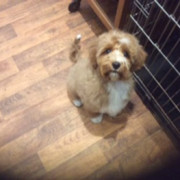Handling – How to help your dog
Getting your dog used to being handled
Helping to understand what a dog experiences when at the groomer will help you prepare your dog.
Picking up
I need to be able to be pick your dog up to be put into the bath and carried across to the table. Is your dog happy being picked up? Look for stress signs and work on happy handling.
Jumping – It would also help if your dog is able to jump into the bath (baths can be lowered to around the height of a sofa or car footwell). Or, if they cannot jump, be able to pop their front legs into the bath and I can then lift their back legs in for them.
Washing and drying
Being comfortable being washed with a shower, including being able to stand whilst being lathered with shampoo and being rinsed off, lifting up each paw and cleaning in-between the pads.
When on the table for drying and trimming, one of the trickiest parts is usually drying and brushing through.
Stand!
We are very good at teaching our pups and dogs to sit. This is a lovely exercise for you and your dog and it teaches control and good manners, but do take the time to also teach a Stand command. It is one of the most time-consuming efforts for a groomer to keep gently encouraging a dog to keep standing, and must be tiring for a dog to continually sit, stand, sit, stand for half an hour or more!
The stand command is also very useful for when you are at the vets and they need to be examined, and also have their temperature taken… can you imagine sitting down with a thermometer in a delicate place! ouch.
You, your dog, your groomer and your vet will thank you for teaching a stand command.
Brushing
How much brushing your dog will need will depend on the type of coat and length of coat they have? Whether you have a pug or a husky, all breeds will benefit from a regular brush; it helps not just the coat, but also your dog’s skin and tightens the bond between you.
In addition, brushing can help you identify potential problems, keep an eye on pests, and your dog will find their groom with me much easier. A happy dog equals a quick no-stress groom.
It’s a win-win for you and your dog. If you are not sure about your dog’s brushing needs, please ask me.
Depending on your dog, you may like to watch my YouTube video about line brushing – brushing a long wool coat – eg poodles and poodle crosses.
Puppies – Introduction
- The whole world is new to a puppy, so I always recommend letting puppies sniff, smell and look at all new equipment.
- Introduce the brush early – don’t let it become a game where they try to get away from the brush or play fight it! I suggest using treats or lickki mats or kongs to keep them occupied and to help them relate brushing to something ‘nice’.
- Keep your handling sessions short – little and often.
- Use it as training and bonding time
- Teach a ‘stand!’ command.
- Introduce noise gently, if you don’t have clippers, an electric toothbrush is a great realistic alternative to the noise of clippers.
- If you don’t have hair dryers, think of other noisy machines they can get used to, eg hoovers, but do this all slowly and controlled.
You can find my blog on introducing puppies to grooming here:
A puppy’s first grooming experience – Stylish Fido,
For all dogs
- Practice inspections of ears, eyes, mouth and nails at least weekly.
- Lift up ear flaps, hold muzzle and lift up lips to see teeth regularly to get your dog used to it.
- Handle paws and handle gently each nail and pads. – there is also a YouTube video on nail clipping for small and big dogs, white and black nails.
- Groomers and vets often need to hold a dog’s muzzle, and this is sometimes tricky for a dog to tolerate at start. Imagine trying to trim around the delicate eyes on a moving target.
…and did I mention teaching a stand command?! 🙂







